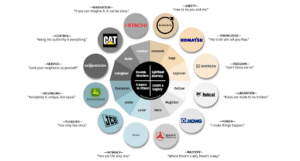Leadership
Leadership
This week, our guest writer Christopher Kiely writes about the ways in which Leadership can become more effective when it comes to people.
$366 billion dollars. If you spent $366 billion dollars on training only to obtain negligible to non-existent results you might start thinking you were wasting money, or at least most people would. Not corporations though. In 2019 an article by Chris Westfall for Forbes magazine¹ put the yearly global Leadership training expenditures at $366 Billion, yep Billion with a B. You can use your Doctor Evil voice, it is appropriate. $166 billion of that is apparently spent in the USA alone. The article goes on to claim most of that training does not work and then cites another article from Chief Learning Officer Business Intelligence Board² that says 94% of corporations “plan to increase or maintain their current investment in leadership development.” Wow!
Let’s recap, $366 Billion spent, mostly on ineffective training, but the vast majority of corporations plan to continue spending on the ineffective training. This is a condemnation of leadership training in and of itself. Who has the gumption to point out the emperor has no clothes (a leadership trait BTW) when it comes to leadership training? Apparently, almost none of the people that had $366 billion spent on them.
If you Google “effective leadership” you will be presented with lists upon lists of “characteristics” and “qualities”, those seem to be the two prevalent terms used, some lists will be 6, some 10, others 12. There seems to be variation in how many qualities are required. Just as there is variation in what those qualities are, but a few do stand out. Listening, empathy and being “authentic” come up a lot. Not sure how you train those things to adults and apparently after billions spent neither do leadership trainers.
I have been in the communication courses where we learned what designated colour or shape everyone was and how their colour or shape changes how we communicate with them, I was a blue square, for what that is worth. I have taken the course where we all learned each other’s Meyers-Briggs personalities and how to effectively work and lead different personality types. I have taken part in different forms of empathy training and team building initiatives. None of them changed anything, the next day we all went back to being ourselves and doing as we do… which is what people do, because it is what people want. They want to be themselves, warts and all.
If you Google “define leadership” you get “the action of leading a group of people or an organization”. A not infrequent case where a form of the word being defined (i.e., leading) is being used to define the word (i.e., leadership). A leader leads. Ahhh… got it, thanks for that Google.
What even is a leader? How does one become someone that takes part in the “action of leading a group”? Most people are simply designated leaders. Paying big bucks for some MBA or other C-suite qualifying degree from some fancy business school makes you a “leader” apparently, then you move up the leadership ladder chosen not by those you will lead but those that designate you to be the leader. Seems dubious to me.
Some people are leaders, and some are not and most of what is learned about the basics of leadership characteristics is learned young. Most the “characteristics and qualities” used to define effective leadership are developed during youth or they are not developed or even developable at all. If billions down the drain with little to no positive results proves anything it is that training adults to be leaders doesn’t really work. Sure, you can perhaps blame some bad training, or cliche training programs with more sizzle than steak and even a leadership development industry that is more about personal branding and making money than developing leaders. There are plenty of all three.
But a follow up article³ to the initial Forbes article was written by Kevin Kruse a year later, in it he gives 6 reasons for why the money was wasted. He begins to get to the heart of the matter with “Reason #2: Training Too Late”. If you are seeing the need to train adults how to “listen” have “empathy” and be “genuine” (i.e., don’t only think and listen to yourself and try not to be a phoney). It seems to me you don’t have a training problem as much as you have a narcissist problem. Leadership training is full of these sorts of nuggets. Harvard Business School online⁴ adds “Integrity and Accountability” with “…’high moral standards’ as the most important leadership competency.” I’m not sure “morals” are a “competency”. If you are planning to train morals into a bunch of 30-something C-suiters, good luck to you.
What has happened to create a corporate culture where hating one’s boss is common, where the phrase “people don’t quit their job, they quit their boss” becomes cliché? When it is already becoming difficult to attract young talent can we really persist with known issues of decades past? There needs to be a fundamental shift in the notion of corporate leadership. You may begin to notice I like the “fundamental” changes; we’re swinging for the fences over here folks, I need to make it worth the price of the ticket for you.
That same Harvard Business School online post that talked about needing morals had “Ability to Influence Others” as the number one characteristic of being an effective leader, stating:
“…influence is “the ability to produce effects on other people’s behavior.” Influencing others requires building a strong sense of trust with your colleagues. “This means [you] need to understand the types of resources people value when it comes to achieving safety and self-esteem,” says Harvard Business School Professor Julie Battilana.”
Uhm??? Not tell Harvard what-is-what, but that is kind of messed up. Leaders should not be seeking to “produce effects” on their employee’s behaviors by manipulating their “safety or self-esteem”, that is Machiavellian nonsense. Do we wonder why we have a narcissist problem? Do we really wonder why people hate their boss if this is what the elite schools are telling the C-Suiters? Enough with the designated top-down “leaders” and the billions wasted trying to turn adults in to caring empathizers with morals that then apparently will seek to “produce effects” on people’s behaviors by manipulating their self-esteem. What a colossal mess this whole corporate “leadership” notion has become.
I played a lot of youth sports when I was young. You know youth, when you learn empathy and morals. The best most effective team I ever played on was barely coached, it had no top-down leadership at all. We had a head coach that was always busy and a few dads that supervised us. We lost one game in two years of competitive rep-football. That team was successful because even at 12-15 years of age it had strong natural leaders, no billions needed. And they mentored a culture of caring and accountability. Where each and everyone of us knew the other had their back and would perform at the expected level and if we didn’t, we would call each other out on it, but only in the huddle and only ever that once. And if you needed help blocking the giant from the other team, you got it. All that leadership pre-Harvard business school. Wow, almost like you don’t teach that stuff…
I have spent 20 years now training various corporation’s employees all over the world. If you have been a mechanic’s trainer you know a lot of venting goes on in training sessions, perhaps this is unique to mechanics, but I don’t think so. When people are removed from their daily work environment they tend to talk, probably where the slang “talking out of class/shop” came from. They say as a trainer you learn more from the class than they do from you, it is often true. I have learned most people do indeed hate some of their bosses (there are layers) and often for good reason. I have learned some people are leaders and some are not, and some are active (in the moment) leaders, the doers, and some are passive (after the fact) leaders, the listeners. The main lesson on leadership I learned is that it is naturally occurring in almost all groups, a lesson I originally learned on the football field when I was 12.
What most corporations fail to do is recognize, legitimize and foster it and you don’t really do that by designating anyone “the leader” or by bringing in “leaders” with big degrees from outside the group, unless you have some serious problems with current group dynamics. You foster internal groups with a sense of accountability and caring that have people that are the natural leaders of the group acting as mentors, not designated top-down authorities. If done right, you are selecting the people the group wants in those positions, no authority is required. No one needs to be “in-charge” and these types of working groups if structured right will often self-regulate to ensure no one considers themselves such. If the quarterback of a football team suddenly starts thinking he is the main man-in-charge, the offensive line quickly reminds him otherwise. If the people who are natural leaders lack the business acumen or skills to be entirely successful in the designated rolls than corporations should be training those competencies and skills, not trying to train “listening, empathy and morals” to the tune of $366 billion a year, that is a lot of college MBA degrees.
- https://www.forbes.com/sites/chriswestfall/2019/06/20/leadership-development-why-most-programs-dont-work/?sh=636f883b61de
- https://www.chieflearningofficer.com/2018/03/21/follow-the-leadership-spending/
- https://www.forbes.com/sites/kevinkruse/2020/01/07/top-6-reasons-your-leadership-development-program-is-failing/?sh=764f7eea74fc
- https://online.hbs.edu/blog/post/characteristics-of-an-effective-leader








